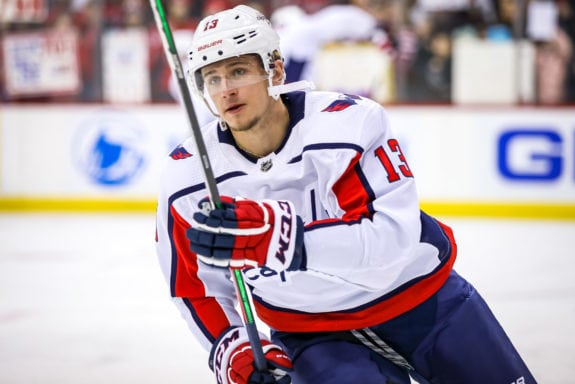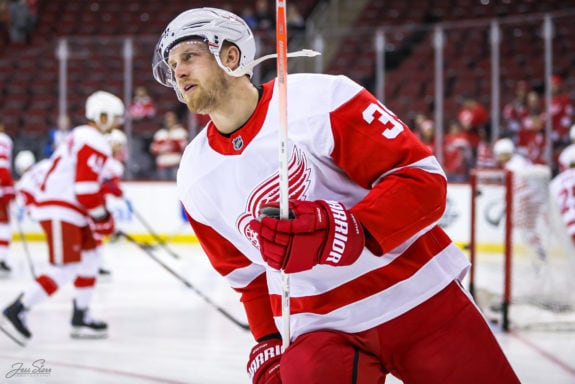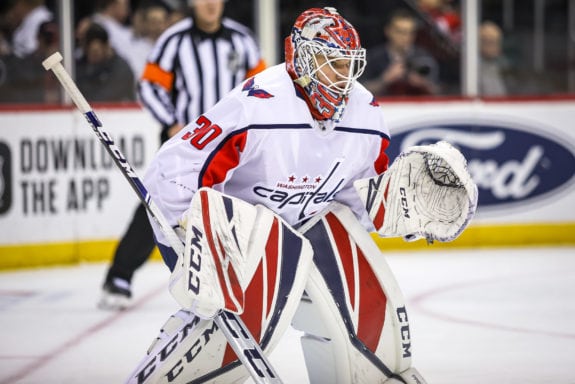While the blockbuster trade with the Detroit Red Wings on Monday was meant to bolster the Washington Capitals’ Stanley Cup hopes, it was also designed to give the team more cap certainty heading into next season. Anthony Mantha, unlike most players who changed sweaters at the deadline, isn’t going to hit the open market this summer, nor will he be able to file for arbitration or attract an offer sheet as a restricted free agent. He has three more years on his deal, which was signed with Detroit in November, meaning he won’t hit the open market until 2024.
Mantha, 26, has 10 goals and 11 assists this season and is two seasons removed from his first 25-goal campaign in 2018-19. The player he was traded for, Jakub Vrana, is just over a year younger than him and scored 11 goals for the Capitals this season and notched his first 25-goal campaign in the truncated 2019-20 schedule.
Given that, on paper, the two players seem fairly even, what was the driving force behind this player swap?
Mantha’s Cap Certainty
While Mantha makes a sizable $5.7 million against the cap on his deal, Vrana is going to be a restricted free agent this summer after his two-year, $3.35 million-per-year bridge deal expires. He is also due for a decent raise and should command between $4-$5 million next season or higher if years are added in a longer-term deal.

Capitals head coach Peter Laviolette was unhappy with Vrana recently and scratched him for two games, which means he was likely to be moved out of Washington sooner or later. Also, with the flat cap next season, it would have been hard for the team to fit him under their cap with a higher salary.
General manager Brian McLellan told reporters on Monday that Vrana wasn’t pleased with his role under Washington’s new coaching staff: “Jakub’s a little frustrated with where he’s at here within the organization, probably wants a little more ice time, wants more responsibility, and there was a tug-of-war between coaching staff and staffs that have had him and the way he was playing,” McAllen told reporters (from ‘Caps land Anthony Mantha from Red Wings in deadline blockbuster for Jakub Vrana, Richard Panik,’ Washington Post, 04/12/2021).

Vrana is more of a skill player who may have been streaky, whereas Mantha, given his 6-foot-5 frame, can crash the net and use his size. In the team’s East Division battles this year and with the return to normal divisions next season, Washington wants to play a heavy game, and Mantha’s size fits the bill.
Mantha has yet to appear in a Stanley Cup playoff game, while Vrana scored a key goal in Game 5 of the Capitals’ Stanley Cup clincher against the Vegas Golden Knights in June 2018. However, that also was his last playoff point for Washington in 15 games, including last season’s qualifying round.
Panik’s Contract a Key
The other undervalued part of this deal was Richard Panik, or more specifically, trading his contract. Panik, who was put on waivers last week and moved to the taxi squad, has two more seasons after this one with a $2.75 million cap hit. Even if we assume Vrana gets a small raise to $4 million per season this summer, along with Panik’s salary, their combined cap hit would be over $1 million more than the Caps will pay Mantha.

While MacLellan has had a good track record signing players since he took over the Capitals, Panik never really seemed to be a good fit. “It never seemed to click for him here,” MacLellan told reporters, according to the Post. “He’s had periods where he’s played really well for us and then had other periods where I don’t think he got, in his mind, enough ice time and enough opportunity. So the trade for him gives him a chance to move up in a lineup and get more ice time.”
While the Capitals also gave the Red Wings a pair of picks in the deal, a 2021 first-rounder and a 2022 second-rounder, it’s safe to presume at least one of those was a sweetener to take on Panik’s contract, which would have been very difficult to move without some sort of incentive.
Looking Ahead
While other teams were looking to boost their lineup for a run at the Cup, the Capitals also played the long game with their deadline moves, acquiring a player whose term and cap hit is less than had they kept Vrana and Panik.

Also, after Vrana’s trade goaltender Ilya Samsonov became Washington’s lone restricted free agent in need of a contract for next season. In terms of unrestricted free agents, the big question mark is captain Alex Ovechkin and what he will get when his 13-year-deal expires this summer. It’s expected the 35-year-old will command at least north of a $10 million cap hit for a few more seasons.
Otherwise, Zdeno Chara, Conor Sheary and the newly acquired Michael Raffl will hit the open market without a new deal this summer.
As teams were looking forward to spring with their deadline deals, the Capitals were looking toward next season and tried to gain some cost certainty ahead of the offseason.